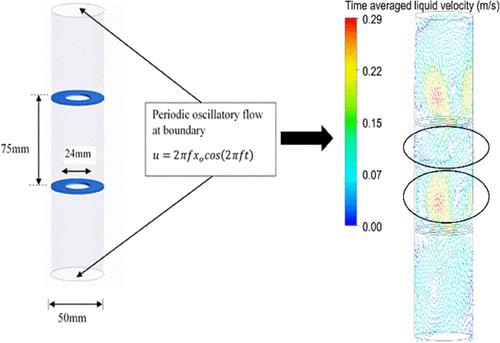当前位置:
X-MOL 学术
›
Ind. Eng. Chem. Res.
›
论文详情
Our official English website, www.x-mol.net, welcomes your
feedback! (Note: you will need to create a separate account there.)
Numerical Simulation of a Gas–Liquid Oscillatory Baffled Column Focusing on Hydrodynamics and Mass Transfer
Industrial & Engineering Chemistry Research ( IF 3.8 ) Pub Date : 2022-06-22 , DOI: 10.1021/acs.iecr.2c00621 Panneerselvam Ranganathan 1
Industrial & Engineering Chemistry Research ( IF 3.8 ) Pub Date : 2022-06-22 , DOI: 10.1021/acs.iecr.2c00621 Panneerselvam Ranganathan 1
Affiliation

|
This work involves the study of the fluid dynamic and mass transfer behaviors of a gassed oscillatory baffled column (OBC) using a coupled computational fluid dynamics (CFD)–population balance model (PBM). First, the liquid flow behavior and power dissipation rate of the OBC were studied. The CFD model result of averaged liquid velocity in the OBC was validated with the literature experimental data. The power dissipation rate obtained from CFD simulation was compared with the correlation of the quasi-state model (QSM) and eddy enhancement model (EEM). The model prediction matches well with the QSM. Furthermore, the study was extended to investigate the fluid dynamic and mass transfer behaviors in the OBC by predicting gas holdup, bubble size distribution, and volumetric mass transfer coefficient (kLa). The averaged quantities of these quantities were compared using the experimental data. The results show adequate agreement with the experimental data. Also, the local behaviors of the liquid flow pattern, gas holdup, and mass transfer in the OBC were discussed. The time-averaged liquid flow patterns in the OBC show two circulation cells in the interbaffle zone of the OBC. Furthermore, the influence of operating parameters on gas holdup and kLa in the OBC was investigated. Finally, this work was extended to study the flow dynamics of an oscillatory inclined baffled column as an intensified OBC. The type of intensified OBC has not yet been reported in the literature. The results show the low power dissipation rate for the inclined baffled column compared to the conventional OBC. The main contribution involves the prediction of mass transfer behavior in the gas–liquid OBC through CFD simulation, which has not been attempted in the literature.
中文翻译:

以流体动力学和传质为重点的气液振荡挡板柱的数值模拟
这项工作涉及使用耦合计算流体动力学 (CFD)-种群平衡模型 (PBM) 研究充气振荡挡板柱 (OBC) 的流体动力学和传质行为。首先,研究了 OBC 的液体流动行为和功率耗散率。用文献实验数据验证了 OBC 中平均液体速度的 CFD 模型结果。将 CFD 仿真得到的功率耗散率与准状态模型 (QSM) 和涡流增强模型 (EEM) 的相关性进行了比较。模型预测与 QSM 匹配良好。此外,该研究通过预测气体持率、气泡尺寸分布和体积传质系数(k L一)。使用实验数据比较这些量的平均量。结果显示与实验数据充分吻合。此外,还讨论了 OBC 中液体流动模式、气体滞留率和传质的局部行为。OBC 中的时间平均液体流动模式显示 OBC 的隔板区域中有两个循环单元。此外,操作参数对含气量和k L a 的影响在 OBC 进行了调查。最后,将这项工作扩展到研究作为强化 OBC 的振荡倾斜挡板柱的流动动力学。强化型 OBC 的类型尚未在文献中报道。结果表明,与传统的 OBC 相比,倾斜挡板柱的功率耗散率较低。主要贡献涉及通过 CFD 模拟预测气液 OBC 中的传质行为,这在文献中尚未尝试过。
更新日期:2022-06-22
中文翻译:

以流体动力学和传质为重点的气液振荡挡板柱的数值模拟
这项工作涉及使用耦合计算流体动力学 (CFD)-种群平衡模型 (PBM) 研究充气振荡挡板柱 (OBC) 的流体动力学和传质行为。首先,研究了 OBC 的液体流动行为和功率耗散率。用文献实验数据验证了 OBC 中平均液体速度的 CFD 模型结果。将 CFD 仿真得到的功率耗散率与准状态模型 (QSM) 和涡流增强模型 (EEM) 的相关性进行了比较。模型预测与 QSM 匹配良好。此外,该研究通过预测气体持率、气泡尺寸分布和体积传质系数(k L一)。使用实验数据比较这些量的平均量。结果显示与实验数据充分吻合。此外,还讨论了 OBC 中液体流动模式、气体滞留率和传质的局部行为。OBC 中的时间平均液体流动模式显示 OBC 的隔板区域中有两个循环单元。此外,操作参数对含气量和k L a 的影响在 OBC 进行了调查。最后,将这项工作扩展到研究作为强化 OBC 的振荡倾斜挡板柱的流动动力学。强化型 OBC 的类型尚未在文献中报道。结果表明,与传统的 OBC 相比,倾斜挡板柱的功率耗散率较低。主要贡献涉及通过 CFD 模拟预测气液 OBC 中的传质行为,这在文献中尚未尝试过。











































 京公网安备 11010802027423号
京公网安备 11010802027423号